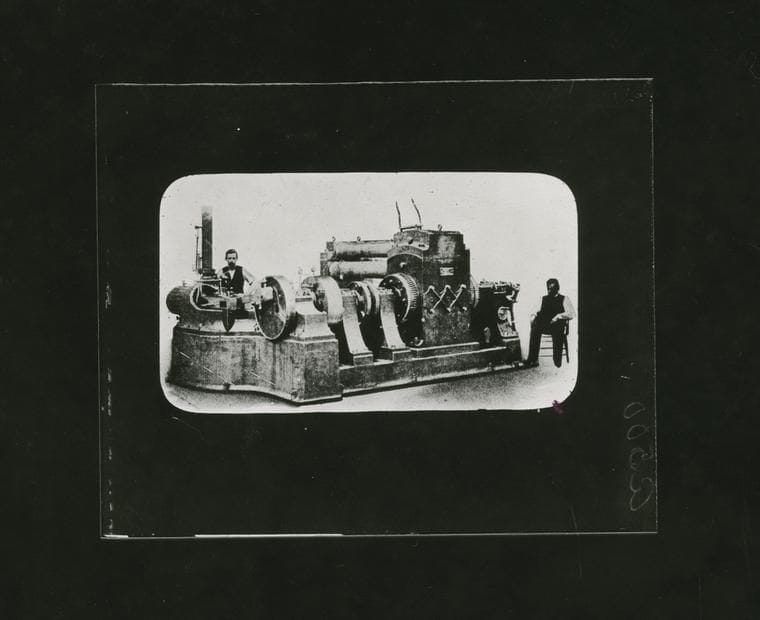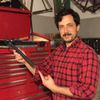- Oh boy, am I really going to try to explain how particle accelerators work? You know the feeling: You read one physics book (in this case Feynman’s QED, which the SOW Reading Group just finished) and then find yourself trying to explain why you’ve found it so captivating, getting way out over your skis and sputtering out just two sentences into what should probably be a ten-part explanation. No, I’ll not do that; I will, however, point out that early particle physics experiments produced staggering quantities of black-and-white images, which needed to be inspected (“scanned”) by human beings in order to find interesting events. Here’s a short article on CERN’s website that describes the process as putting “a lot of strain on the eyes.” And get this, from an interesting-looking book about scientific discovery by the National Academy of Sciences:
The [bubble chamber at Brookhaven National Lab] could generate photos by the tens of thousands, and people had to go through all of them to look for interesting events. Lowly graduate students often handled this tedious work, but at times they were in short supply. When that happened, the job often fell to local housewives who needed the extra income. At Brookhaven the woman who supervised this work was a former YMCA cashier; she had gained her post because she had a talent for telling her co-workers what the physicists were looking for. When the lab recorded its first evidence for the charm quark in May 1974, the data came from a former switchboard operator.
- New York City was assembled from smaller municipalities over a century ago, but STILL it lacks a single unified map. “Instead, each borough maintains its own sets [of maps], resulting in more than 8,000 maps citywide.” This might, at long last, be changing, as a ballot initiative this fall seeks to establish a unified City Map.
- Also in municipal news, the iconic Soho location of Recreational Equipment Incorporated, a.k.a. REI, will close “late in 2026.” I was surprised to learn that this store, whose location (both the Puck building and the surrounding blocks) feels very old school New York, only opened in 2011. Nevertheless its closure feels like a real loss, and has been brought up in conversation by many New Yorkers as a means of seeming middle-aged and, er, “old school New York.” To wit, I myself worked more or less across the street from the REI for a year and a half, and was utterly enchanted by the whole neighborhood. At the time the lot directly across from REI was a gas station (to think!), and then a few doors down was the Supreme store, and next to that the La Colombe with its sumptuous curved glass entryway. The La Colombe often had one or two people waiting out the door for their cappuccinos, and whenever the Supreme drops happened there seemed to be well-groomed youths camped out all night. Speaking for myself, it was pure bliss to be even remotely aware of these places. I never stepped foot in the Supreme, and I preferred getting coffee at the Gasoline Alley across Houston, but to be even vaguely aware of the goings-on in a neighborhood like Soho is a treat worth writing home about. Somehow, though, I didn’t develop strong sentiments towards the REI until well after I ceased commuting into Soho, and it really wasn’t until my kids were talking that I decided that it was fun to take the 3, then the 4/5, and finally the 6 to Spring Street to reemerge into the preeminent high-end retail neighborhood in the country. As it happens, I took this very journey a few days ago, with my six-year-old, and it warms my heart to report that it has held up.
- A pretty funny blog post offering advice for anyone attempting to steal a particular Porsche 914.
- Re: Sweden’s trash incinerators, which I mentioned a few weeks ago, here’s a blog post on the EPA’s updated (2024) standards on “large waste plants that burn municipal solid waste.”
Tired of CAD crashes? With Onshape, you'll never experience another crash again or lose your work. Try Onshape Professional for free.
- I’m reading Graham Greene’s Our Man in Havana and listening to Zadie Smith’s Swing Time, which reminds me somewhat of Jonathan Lethem’s The Fortress of Solitude: Both are about narrators grappling with partially-forgotten childhood friendships, and both concern race, and both make pop cultural references that I find resonant. Anyway, I am enjoying being engrossed with Smith’s characters, who strike me as flawed but well-intentioned — a description that I think any reasonable person would aspire to.
- Fondant icing is made of sugar, water, fat, gelatin and glycerine, and is pliable and doughy and not particularly flavorful. Fondant tends to be very smooth and easy to sculpt — it can look almost molten — and its name, which is French for “melting,” is related, etymologically, to words like “foundry” (a facility that makes metal castings) and “fondue” (a pot of molten cheese).

Thinking out loud here: Thomas Edison's Pearl Street Station started generating power in 1882, and became profitable in 1884 or 1885. Pearl Street served a tiny portion of lower Manhattan; the rest of the city got access to electricity around the turn of the century, but even in 1930 something like thirty percent of US households still lacked a grid connection. The Rural Electrification Act, which was championed by Texas Representative Sam Rayburn, was passed 54 years later, in 1936. In 1959, after something like $10B in (2021 dollars) expenses, Rayburn claimed that 90% of US farm homes had access to power. So, 75 years passed between power stations being economically viable, and power being available to nine out of ten of farm homes.
ChatGPT launched in 2022, and OpenAI has since raised (and presumably spent) something like $58B. Unlike Edison’s operations, OpenAI remains far from profitability. We could probably argue that this is by design; they're not aiming for profits but for dominance, which they (think they will) achieve by vacuuming up huge amounts of VC money and spending it as quickly as they can. By doing this, they've built a weekly active user base of around 700 million people — roughly double the population of the US.
I'm not totally sure what I'm swirling around here, but I guess I'm curious about whether anyone proposed open-sourcing Edison's inventions — the Jumbo Dynamos that made Pearl Street profitable, maybe — in that couple of years before his power plant was profitable. This is not a fair comparison — ChatGPT and the Jumbo Dynamo — but it's at least notionally reasonable, and it feels useful to keep old technological histories in mind when grappling with the seemingly existential stuff happening today.
Recently, while visiting the Lost Sierra (a region of the Sierra Nevada mountains to the north and west of Lake Tahoe) with my family, I learned that a truck had backed up to the lake we were staying on, and had dumped thousands of fish out of a tube in its rear end, much as can be seen here. This lake — called Salmon Lake, though I’m not sure there have ever been salmon there — has a road that’s drivable in the non-snowy months, but some of the smaller lakes higher up in the region used to be stocked in a more dramatic fashion: by little single-prop airplanes flown up into the mountains, swooping down in dive-bombing patterns to dump fingerlings (juvenile fish) from their holds. It’s a process that’s still performed today in some places — namely Utah — but when I was young it was described to me as an outdated way of distributing fish in the Sierra, a way of keeping old fighter pilots active. This may have been inaccurate; it appears that some Sierra lakes have been restocked by plane this century:
Jagged mountain tops towered over us directly out the window as we took our initial dive into a deep chasm in search of our drop zone. “Let ‘em go!” were the only words the pilot directed at me that early autumn day over the piercing sounds of the low altitude alarms. As the emerald treetops gave way to cobalt glacier formed lakes of the Sierra Nevada’s western slope, an instant rush of air flooded the cabin when I pushed the lever, opening the door in the belly of the plane. We pulled out of our dive-bomb and banked hard left, as if avoiding return fire, to look out the window and ensure our payload had hit its intended mark. An “affirmative” from the pilot to the copilot meant a job well done, and it was off to our next target.
Apparently this practice continues; here it is being done in 2022. By truck or by air, though, I think the whole operation is quite weird. We breed, nurture, and distribute these fish just so they can be caught and killed. We operate a significant amount of infrastructure to support trout populations: Our government, or parts of it anyway, consider these fish to be something akin to a utility, a resource that needs to be maintained and distributed to alpine waterways that almost nobody visits and which aren’t even their natural habitats. From Kim Stanley Robinson’s The High Sierra:
The early volumes of the Sierra Club Bulletin are filled with enthusiastic reports of the efforts made by club members to move the golden trout they had found, an endemic species confined to the upper reaches of a few streams south of Langley, to the rest of the range. Big buckets tied to the sides of mules; forced marches to get the fish to their destinations alive; the pretty trout introduced to streams and ponds all over. These accomplishments the writers were proud to describe. Later, both the National Park Service and the US Forest Service arranged to introduce golden trout and other kinds of fish to many lakes and ponds in the high Sierra that had never had the fish before. Giving fishermen something to catch was a priority. For a while, helicopters and small planes would swoop down over high lakes every spring and drop fingerlings into them as if dousing fires.
Robinson goes on to describe the destruction that the fish’s introduction has caused, especially on the frogs that actually are native to the high Sierra. And I’m with him: We shouldn’t stock fish, probably at all and definitely not in places where they’re not from. But I can also see some optimism in the whole thing. For better or for worse, people have gotten together and decided to fund this weird part of our government. We employ human beings, dressed maybe in drab suits and operating heavy pieces of land- or air-bound equipment, and their entire job is to make sure that a few hearty species survive, for a time, in environments where hungry but generally well-meaning anglers want nothing more than to hunt and kill them. The whole thing is tragic, sure, but maybe it’s tragically beautiful too.
A pistol squat is a one-legged bodyweight squat — a physical movement, an exercise — which starts and ends in a standing position and is done first on one leg and then on the other. You lift one leg forward, then lower yourself all the way down with the other, then push back up to a standing position, then repeat on the other side.
Stand up, then lift your right leg off the ground in front of you, keeping it more or less straight and maybe pointing your toes a bit. Extend your arms in front of you for balance, then crouch slightly onto your left leg. Then go down: Kick your right leg out a bit higher, and bend your left knee more, and keeping your left foot flat on the floor, lower yourself down until your butt almost touches your left heel. This will be difficult, and it’ll take quite a bit of concentration not to fall back and to one side, both legs in the air, but if you really work on it then it’ll come together into a satisfying, fluid, and totally impressive motion. If you practice this repeatedly then it might even look graceful, and you’ll find that without too much effort you can stay there, perched atop your left foot with your butt, and your right leg, hovering just off the ground. But what you’re working towards is pushing yourself back up, using all the strength in your butt and left thigh, with your right quad in constant tension (keeping my inactive leg elevated is one of the hardest parts of pistol squats) and your core and arms engaged for balance. After practicing this movement hundreds of times I can say that doing it just once, on one side, constitutes a significant achievement. Doing, say, three reps per leg continues to elude me, let alone my original goal earlier this year: three sets of three reps per leg.
But I’ve learned over the past few years that with consistent practice, it’s honestly not that hard to make progress towards goals like this one. If I did, say, five sets of pistol squats, three times a week, then I think I could probably get there before the new year. This is, on the one hand, kind of a big commitment. On the other hand, what the heck else am I doing with my life? I find time to read obscure books, and to wash my bikes off when they’re dirty, and to rearrange my sock drawer every year or two. I mix green fertilizer granules into tap water before watering our houseplants, and line-dry the clothes that’ll benefit from it (most of them), and even change a few of my HVAC filters a few times a year. Why should I not set arbitrary and ultimately unjustifiable goals for how many pistol squats I can do?

A big thanks to Scope of Work's Members and Supporters for making this newsletter possible. Thanks also to Matt, Anna, Mike, and Oliver for helping source links & thoughts this week.




